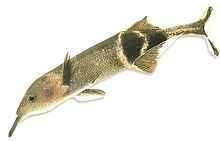Mormyrinae
| Mormyrinae | ||||||||||||
|---|---|---|---|---|---|---|---|---|---|---|---|---|

Gnathonemus petersii (above) and Campylomormyrus tamandua |
||||||||||||
| Systematics | ||||||||||||
|
||||||||||||
| Scientific name | ||||||||||||
| Mormyrinae | ||||||||||||
| Tavern , 1972 |
The Mormyrinae are a subfamily of African freshwater fish from the Nilhechte family (Mormyridae). In German they are called elephant fish or Nilhechte , depending on the shape of their body and snout .
distribution
The range of this fish entirely covers Africa south of the Sahara and the Nile , but without the Capensis . The species-poor genera have smaller distribution areas. Hyperopisus , Genyomyrus and Myomyrus occur only in the Congo river basin , Paramormyrops only in Cameroon , Isichthys in West Africa with the exception of the Congo and Hyperopisus lives in the area between Senegal and the Nile. Of the more species-rich genera, Stomatorhinus is restricted to the Congo and Ogooué river basins .
features
The members of this subfamily are 5.2 centimeters to 1.20 meters long, depending on the species. Body, head and snout shape are very variable. The caudal peduncle is narrow, the caudal fin always forked.
In contrast to the subfamily Petrocephalinae , they lack the basic phenoid (sphenoid bone) and they have two orbitosphenoids (skull bones). The first ray of the dorsal fin is unsegmented (the first two in the Petrocephalinae), all others are segmented. The anal fin also has an unsegmented ray and other segmented ones. The nostrils are clearly separated from each other and are at a greater distance in front of the eyes. The mouth is terminal or below and stands clearly in front of the front edge of the eyes. The unpaired fins are variable in position, size and shape. The dorsal fin and anal fin are located far back on the body and in many cases are symmetrically opposite each other.
Like all Nilhechte the Mormyrinae have the ability for electrical orientation and communication.
Systematics
The Mormyrinae are a subfamily of the Nilhechte (Mormyridae). It includes all species of Nilhechtgus except Petrocephalus , which is based on the other genera and is classified in the subfamily Petrocephalinae.
Genera
There are 21 genera with around 190 species .

- Boulengeromyrus Taverne & Géry, 1968
- Brevimyrus Tavern, 1971
- Brienomyrus Tavern, 1971
- Campylomormyrus Bleeker, 1874
- Cryptomyrus Sullivan et al., 2016
- Cyphomyrus Myers, 1960
- Genyomyrus Boulenger, 1898
- Gnathonemus Gill, 1863
- Heteromormyrus Steindachner, 1866
- Hippopotamyrus Pappenheim, 1906
- Hyperopisus Gill, 1862
- Isichthys Gill, 1863
- Ivindomyrus Taverne and Géry, 1975
- Marcusenius Gill, 1862
- Mormyrops Müller, 1843
- Mormyrus Linnaeus, 1758
- Myomyrus Boulenger , 1898
- Oxymormyrus Bleeker, 1874
- Paramormyrops Taverne, Thys van den Audenaerde & Heymer, 1977
- Round-headed Nilhechte ( Pollimyrus ) tavern, 1971
- Stomatorhinus Boulenger, 1898
Phylogeny
The following cladogram shows the relationship between the Mormyrinae.
| Mormyrinae |
|
|||||||||||||||||||||||||||||||||||||||||||||||||||||||||||||||||||||||||||||||||||||||||||||||||||||||||||||||
|
|
literature
- Melanie Stiassny, Guy Teugels & Carl D. Hopkins: The Fresh and Brackish Water Fishes of Lower Guinea, West-Central Africa, Volume 1. ISBN 9789074752206
Individual evidence
- ↑ Petru Banaescu: Zoogeography of Fresh Waters . Page 63, AULA, Wiesbaden 1990, ISBN 3-89104-480-1
- ↑ Sullivan, J., Lavoue, S. & Hopkins, CD (2016): Cryptomyrus : a new genus of Mormyridae (Teleostei, Osteoglossomorpha) with two new species from Gabon, West-Central Africa. ZooKeys 561: 117-150 (Feb. 2016) doi: 10.3897 / zookeys.561.7137
- ↑ Lavoué, S., Sullivan JP, & Hopkins CD (2003): Phylogenetic utility of the first two introns of the S7 ribosomal protein gene in African electric fishes (Mormyroidea: Teleostei) and congruence with other molecular markers. Biological Journal of the Linnean Society. 78, 273-292. PDF ( Memento of the original from October 30, 2014 in the Internet Archive ) Info: The archive link was inserted automatically and has not yet been checked. Please check the original and archive link according to the instructions and then remove this notice.
- ↑ Sullivan, JP, Lavoué S., & Hopkins CD (2000): Molecular systematics of the African electric fishes (Mormyroidea: Teleostei) and a model for the evolution of their electric organs. Journal of Experimental Biology. 203, 665-683. PDF ( Memento of the original from October 30, 2014 in the Internet Archive ) Info: The archive link was inserted automatically and has not yet been checked. Please check the original and archive link according to the instructions and then remove this notice.
- ↑ John P. Sullivan, Sebastien Lavoue and Carl D. Hopkins. 2016. Cryptomyrus : A New Genus of Mormyridae (Teleostei, Osteoglossomorpha) with Two New Species from Gabon, West-Central Africa. ZooKeys . 561: 117-150. DOI: 10.3897 / zookeys.561.7137

